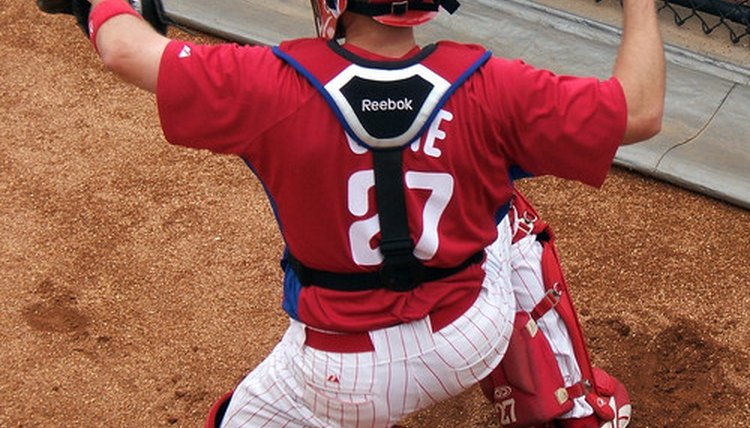Good Stretches for a Baseball Catcher

Baseball catchers endure a lot of stress on their bodies due to the squatting position they must assume during a game. Stretching for catchers can keep the body in good condition and help in prevention of injury.
Back Stretches
Good back stretches to consider are the pelvic tilt, where you lay flat on your back and slowly raise your lower back off of the ground; the spinal twist, which increases circulation in your lower spinal area by using a twisting motion; and different gluteal stretches, which increase circulation in the muscles that connect the hamstring to the lower back. An example of a good gluteal stretch is to lay flat on the ground on your back, pull your knees into your chest and hold the position.
Calf Stretches
Good calf stretches to consider are the wall lunge, where you lean against a wall and--while your feet are flat--extend one leg back and continue to hold the position; and the toe pull, where you sit on the floor with your legs extended and reach to grab your toes.
Groin Stretches
Good groin stretches to consider are the butterfly stretch, where you sit on the ground with your knees bent and pointed out to the side and push your legs towards the ground; leg lunges, where you are in a standing position and your forward leg is bent as you lean forward onto that leg; and the supine stretch, which is a similar motion to the butterfly stretch, but you lay down on the ground instead.
Leg Stretches
As a catcher, stretching hamstrings and thighs are very important, as well. For hamstrings, a good stretch is when standing up, keep your legs straight and bend over to touch your toes and hold the position. For thighs, when standing up, bend one knee backward and hold it up and pull to get a good stretch. Being in the squatting position when catching in a baseball game can cause cramps in the legs, so these kinds of stretches are essential.
Shoulder Stretches
Good shoulder stretches are arm circles, where you extend your shoulders and rotate in a full circular motion; the anterior shoulder stretch, where you clasp your hands behind your back and extend upward; and the posterior shoulder stretch, where you hold one arm across your chest and pull it in with your free hand.
Writer Bio
Alex Oppenheimer has been writing Sport and Recreation related articles since 2001. He has previously written for publications such as The Miami Herald, INASECTV.com, Hurricanesports.com (University of Miami Athletics), Thesportsrooster.com (Florida High School Sports) and The Metropolitan Golf Association (NY). He holds a degree in Sport Administration from the University of Miami (FL).
